Ghulam Misbah, Lecturer, Jamia Ahmadiyya Canada
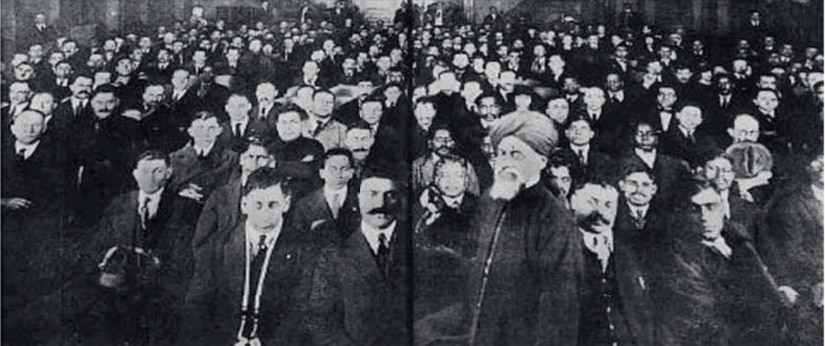
The arrival of Hazrat Mufti Muhammad Sadiqra (1872-1957) in America not only propagated the message of Islam in North America under the divine institution of Khilafat-e-Ahmadiyya, but it also caused a religious awakening among the Muslim immigrants living in America.
A large number of Arab Muslims (Syrians, Lebanese, Jordanians, Palestinians and others) were residing in Detroit (Michigan) and New York City and their suburbs. They were divided along ethnic and racial lines. Religiously, they were inactive and thus unable to spread Islam. Having heard and read about Hazrat Mufti Sadiq’sra appointment as an Islamic missionary, the Muslims of the Midwest and Northeast invited him and arranged his lectures on Islam.
After spending a few weeks in Philadelphia where he landed, Hazrat Mufti Muhammad Sadiqra stationed himself in New York in 1920. It was only after the fourth month that the Arab immigrant Muslims of Detroit, Michigan invited him for a lecture, so he travelled from New York to Detroit in June 1920. An Arabic newspaper of New York, Al-Bayan reported his visit in its edition of 26 June, 1920 as follows:
[Translation] “The Islamic Community in Detroit, Michigan has held a general body meeting on 14 June for the reception of Mr Mufti Muhammad Sadiq, one of the best men of India. He has come all the way from New York especially just to visit the Islamic community here in this city.
“Mr Mufti began this meeting with the following words: ‘In the name of Allah, and blessings be sent upon the Holy Arab Prophet’; then he delivered his address in both English and Arabic. He expressed how the Muslims of India were highly determined and dedicated to uplift the pride of Islam again, and how supportive they were towards their brothers in the East and the West. His address left a noble impact in the hearts of attendees.” (Al-Bayan, 26 June, 1920, p. 3, 26 Court St. Brooklyn, N. Y.)
Considering Chicago to be a suitable place for an Islamic centre, he moved there in August/September 1920 and carried on his missionary work.
In February 1921, he was invited again to Detroit for lectures, so he arrived there on 5 February 1921. With the characteristic hospitality of Arab Muslims, he was offered a friendly and generous reception and accommodation. He stayed for more than a month in Detroit and its suburb Highland Park with these Arab Muslim friends and delivered a series of lectures on Islam.
The Detroit Free Press, the largest newspaper of Detroit, gave full coverage to his activities in several of its editions. For example, it reported under the heading “Moslems Avow Loyalty To U.S.”:
“Islam set before big businessmen and governmental heads of the neighbour city Sunday the most savory of Eastern dishes in a dinner tendered to Professor Mufti Muhammad Sadiq of India, missionary of the Ahmadia movement […]”. (The Detroit Free Press, Monday, 14 February 1921, p. 3)
Reporting the same event, the Arabic newspaper Al-Bayan stated under the heading: اكابر الاميركان علی مائدة عربی (i.e., American dignitaries on the Arab dining table):
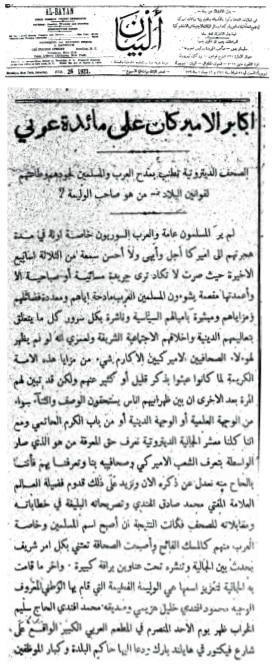
[Translation] “What Muslims generally and Syrian Arabs especially have witnessed during the last three weeks, they have neither seen such a magnificent time since their migration to America, nor have they attained such popularity. You will not find any morning or evening newspaper that is not filled with the joyous mention of their praise, their qualities, their religion, morals and lifestyle. And I swear that the sincere American journalists would never have mentioned them if the beauties of this noble ummah had not been made apparent to them […]
“Furthermore, we can say that due to the coming of Allama Mufti Muhammad Sadiq of India, and as a result of his eloquent speeches and interviews with all the journalists, the name of Muslims and especially Arabs has spread like fragrance […]” . (Al-Bayan, 19 February, 1921, p. 3)
On 21 February, two Arab brothers, Ahmad Afandi Hamza and Ahmad Afandi Osman, also arranged another big lunch in honour of Hazrat Mufti Sadiqra, followed by his address and other speeches. (Al-Bayan, 26 February 1921, p. 3)
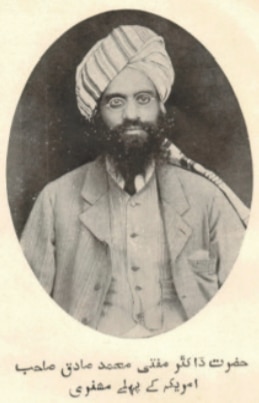
Thanking Arab brethern for their kind hospitality, Hazrat Mufti Sadiqra later wrote:
“Arabians have a world-wide reputation for hospitality […] Thanks Allah, I have met examples of this hospitality right here in America in the venerable personalities of Mr. and Mrs. Restum, Mr. Shamee of Detroit, Mr. and Mrs Karroub, Mr. S. A. Zehra of Highland Park […]” (The Moslem Sunrise, No. 1 July 1921, p. 16)
His detailed report about this tour of Detroit and its neighbouring cities is published in the 7 April 1921 issue of the official newspaper of the Ahmadiyya Jamaat, Al Fazl Qadian. In it, he gives a brief introduction of Detroit City and then highlights his activities during this tour. These were truly days of grace in Detroit, when Hazrat Sadiqra presented the true picture of Islam and its founder in front of the West on such a large scale. He also advised the Muslim community in the following words:
“A democracy in republic such as we find in the United States today is exactly according to the spirit of Moslem government that was established in the beginning by the Moslem caliphs, which was a government of the people, for the people, by the people. When my Moslem brethren try to be good citizens in this country, they perform one of the first great religious duties of their faith. Be honest to the country and people where you are, be loyal to their flag, try to take your best part in the patriotic, social benevolent and charitable works, learn the American language thoroughly, this is my advice.
“Last but not least, I advise my brethren to spread the faith of their forefathers, not in any aggressive way but by the good example of right thinking, right speaking and right acting […] hating no one and loving all, and thus proving to be good followers of the great master prophet.” (The Detroit Free Press, 14 February 1921, p. 3)
One of his hosts, Muhammed Karoub, a Syrian immigrant real state agent, had intentions to build a mosque. Hazrat Sadiqra left for Chicago, planning to return at the completion of the mosque. On the way to Chicago, he was given a warm welcome by the Syrian community of Michigan City, Indiana. A banquet was also held in his honour where he delivered a lecture (Al-Bayan, 29 March, 1921, p. 3). The whole programme was announced earlier in The Michigan City News on 8 March, 1921.
While he was in Chicago performing his missionary duties, internal controversy began about the construction of the mosque. Apart from the rivalry of the factions within the community, there was the question of the mosque: Would it serve as a mere place of worship or a community and cultural place as well?
Both parties used the Al-Bayan newspaper as their platform for arguments. Nevertheless, Karoub carried on the construction and the mosque – though not fully completed – held Eid-ul-Fitr prayer at the end of Ramadan in June 1921. Hazrat Mufti Muhammad Sadiqra was back in Highland Park, and he led Eid prayer followed by the sermon delivered by Hussain Karoub, the brother of Muhammad Karoub. The Eid celebration continued after the Eid prayer as a parade was arranged on Victor Ave.
Ahmad Badar, a representative of the Arab American United Association reported the whole ceremony in Al-Bayan starting with these words:
[Translation] “The Islamic community of Detroit has neither seen such a magnificent day, nor has it observed such an influential scene of gathering as the one that took place at noon. It was the first of its kind and importance, not only in the city of Detroit, but in the United States or even in the whole American continent.” (Al-Bayan, 14 June 1921, p. 2)
Hazrat Mufti Sadiqra made Highland Park his missionary centre. Soon after, he published his well-known periodical, The Moslem Sunrise from 74 Victor Ave., The Detroit Free Press again gave the heading of “See Highland Park As Islamic Center” (25 June 1921, p. 11).
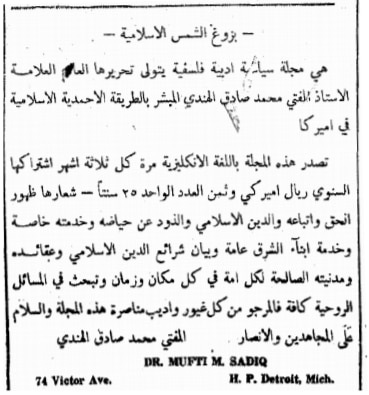
The rival group did not give up; besides other arguments, they also blamed Hazrat Mufti Sadiqra of being a follower of a new prophet and new religion. Before Hazrat Mufti Sadiqra said something in response to this false propaganda, his staunch advocates arose from among the Arab brethren. Aql Ali Al-Muqaddasi, an Arab friend from Detoit, wrote in his letter to the editor:
[Translation] “It is not our intention to respond to the allegations of Mahmood Nasir except for one thing, and that is because he has mentioned us in a matter in which he has insulted a man who is a profound scholar of Islam. He defends Islam with such strength of knowledge and bravery that he has made the popularity of Muslims among the Americans like a fragrance. I cannot imagine that any person who has religious consciousness and holds honour for Islam would not attest to what we say. […]
“If some people had not asked us to testify in favour of Hazrat Mufti Muhammad Sadiq of India, we would not have gone through the trouble to write on this topic […] Thus, we are deeply saddened by the defamatory remarks about Mufti, and we are really surprised at how we could deny his fearless defence of Islam which he does even in churches. And we people of Palestine were introduced to Hazrat Mufti only through the leaders of Detroit, who welcomed him and honoured him and proudly invited him to their dinners. So we are really surprised how things changed and now some people want to defame him in newspapers […]” (Al-Bayan, 9 July, 1921, pp. 4-5)
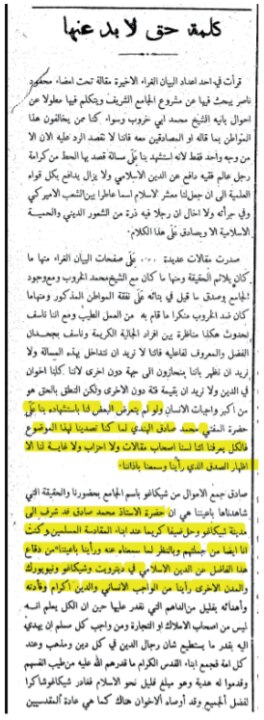
Another friend, Ahmad Badr, stated:
[Translation] “So, among the things which really hurt a proud Muslim is to involve respectable Mufti Muhammad Sadiq in this matter, and to blame him for collecting donations on behalf of Mr Karoub and his mosque. We know that he [Hazrat Mufti Sadiqra] never indulged himself in such people; rather, he constantly engages himself in defending Islam in gatherings, churches and newspapers […] So any fabrication which hurts the feelings of Mufti Muhammad Sadiq also injures the Muslims’ hearts and this is not only insulting to him but this is an insult to all Muslims.” (Al-Bayan, 16 July 1921, p. 5)
Despite all this, Hazrat Mufti Sadiqra carried on with his work and visited Arab Muslims in neighbouring cities. For example, The Toledo News-Bee of Toledo, Ohio reports his visit of two weeks among “Toledo Mohammedans”. (The Toledo News-Bee, 12 July, 1921, p. 1)
For other missionary works, The Moslem Sunrise contains enough details. Under “My Advice to the Muhammadans in America”, one of the points he made is:
“Build a Mosque in every town to worship one God, however small and simple it be, but there must be one. If you cannot build a Mosque, then fix up a room in the house of one of you to meet there every day to say prayers together, read the Quran and Tradition and talk on religious subjects.” (The Moslem Sunrise, Issue 2, 1921, p. 29)
Months of controversy and conflict about the mosque finally forced Karoub to abandon the project and he announced his intentions to put the building up for sale. There are various reasons given for abandoning this project. According to The Detroit Free Press, “[…] in the whole year, not one cent was returned to Karoub. So two months ago he let out the secret that the mosque was to be torn down.” (The Detroit Free Press, 24 September, 1922, p. 75)
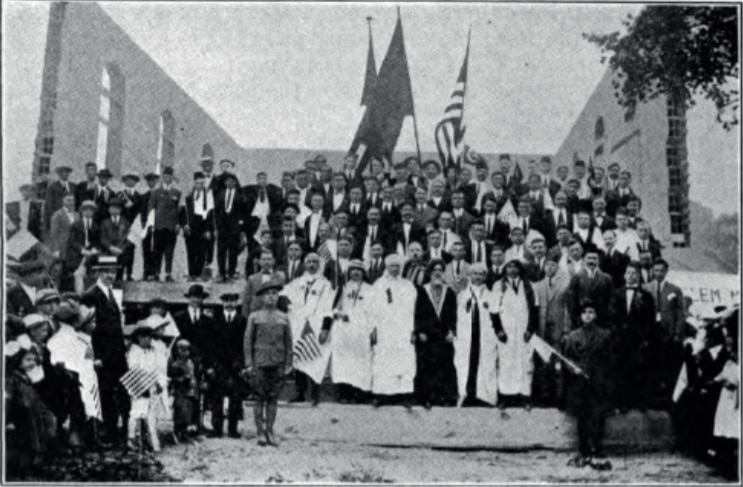
Carl Muller, a representative of The Detroit Free Press visited a frequented coffee house of Turks and Syrians and enquired about the reason of the mosque falling into disrepair. He wrote:
“[…] there are almost as many explanations as there are men.” (The Detroit Free Press, 20 April 1924, p. 52)
Hazrat Mufti Sadiqra moved back to Chicago to avoid any hurdle in his missionary work; nevertheless, he was a key figure of the congregation of Highland Park mosque. The famous Christian scholar, Samuel Marinus Zwemer wrote a note in his periodical The Moslem World and stated:
“[…] the mufti took leave of his group of followers here, and left for Chicago to continue his missionary work. With his departure, the attendance at the mosque services fell off until none came to the mosque on Holy Days […] Mr. Karoub said: ‘I am greatly disappointed that the mosque I built and gave to the people of my faith here is not appreciated; and since I have spent a large sum of money on it, and my purse is bearing the burden of its upkeep and taxes, and there are none to worship in it, I can see no other logical thing to do but tear the mosque down and sell the lots on which it is built […] I have no word of censure for my people. If they differ with me as to the interpretations of the doctrine of Mohammed, that is their affair and their right. I believe fully in the liberty of conscience.” (The Moslem World, Vol. XIII, 1923, p. 83)
Hazrat Mufti Sadiqra himself has not given any reason for his departure from Detroit. However, he still had sincere friends in Detroit who offered him arrangements of his permanent stay in Detroit. He gratefully declined their offers and instead preferred Chicago considering it more suitable for the propagation of Islam. Without any delay, he built a mosque in Chicago and published his next issue of The Moslem Sunrise on time. This was all possible due to funding from the Ahmadiyya headquarter in Qadian, India, and thus removes the misunderstanding created by Detroit Free Press that his missionary efforts were financed by Karoub. (Detroit Free Press, 24 Sep, 1922, p. 75)
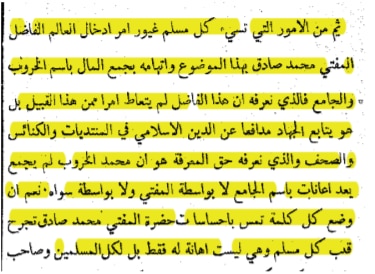
Arab and other Muslims living in the Midwest and Northeast expressed their desire to Hazrat Mufti Sadiqra, asking him to visit them. By the end of 1922, Hazrat Mufti Sadiqra travelled to Ross and Stanley, North Dakota. This journey was undertaken at the invitation of some Arab or Turk Muslims residing near Ross. In his lecture, he thanked brothers Hessen Husain Jaha, Farhat, Omar and others. On his way back, he spent some days conveying the message of Islam in both Crookston and St Paul, Minnesota. (The Moslem Sunrise, Issue I, 1923, pp 166-167)
In The Moslem Sunrise, Issue II, 1923, p. 190, he mentions his tour of New York, Buffalo and Pittsburgh. The Buffalo Times under the heading “Islam Missioner Visits Buffalo” reported:
“Mohammadans of this city are rejoicing for Dr. Mufti Muhammad Sadiq, first and only missionary of Islam to come to America, is here this week. Although he has been in America for three years, this is the doctor’s first visit to Buffalo […]”. (The Buffalo Times, 13 February, 1923, p. 15)
While he was preparing to depart for India, he arranged a short visit to West Virginia and met Muslims working as coal miners in Williamson and Logan. (Al Fazl, 4 September, 1923)
Having reached Qadian, he still received letters from some of the Muslim brothers of America for years.

